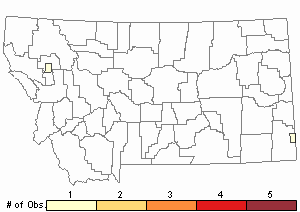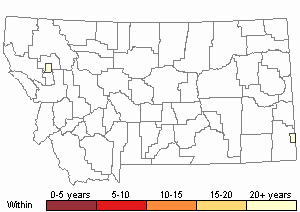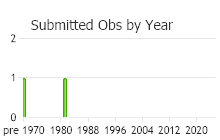View in other NatureServe Network Field Guides
NatureServe
Montana
Utah
Wyoming
Idaho
Wisconsin
British Columbia
South Carolina
Yukon
California
New York
Common Mat Moss - Brachythecium laetum
Other Names:
Brachythecium oxycladon
General Description
Plants: Pleurocarpous (Vitt 1988). Growing in somewhat open to crowded mats, pale to dirty green, yellow (FNA 2014), deep brown below (Flowers 1973), somewhat glossy (Crum and Anderson et al. 1981); rhizoids small in number, not stoloniform (Flowers 1973). Stems prostrate, leafy, circular in X-section, somewhat erratic to pinnate, to 12 cm in length; possessing a central strand. Branches sometimes bowed a little, to 25 mm in length, leafy and round in X-section (FNA 2014), narrowing at the ends (Flowers 1973).
Leaves: Stem leaves upright, closely to loosely overlapping, slenderly deltoid and somewhat egg-shaped, widest a little above the base, strongly pleated longitudinally, slightly cupped, 1-2.2 mm in length, 0.4-1 mm in width; apex narrowing to form an acumen; base curved and extending down the stem; margins finely toothed nearly throughout, flat or turned back and downward in different locations; costa somewhat faint, extending 1/2 to 3/4 of the leaf length. Branch leaves smaller, not as wide (Flowers 1973) nor as strongly pleated as the stem leaves (FNA 2014).
Leaf Cells: Alar cells somewhat opaque (greyish) (Crum and Anderson et al. 1981), fine-walled, nearly square, the alar area not obviously demarcated; basal cells same size or slightly larger than the alar cells, arranged in 3 tiers close to the costa (FNA 2014); upper cells long and narrow (Crum and Anderson et al. 1981).
Diagnostic Characteristics
This species is variable and may be hard to distinguish due to changes in leaf size to cell color and shape following disturbance from trampling or brief flooding (FNA 2014).
Range Comments
North American Range
Canada: East of and including SK; USA: most states except in the Pacific Northwest; Mexico. Extensive in eastern North America, frequently weedy (FNA 2014). Known in Montana from Carter County (Elliott 2016).
Observations in Montana Natural Heritage Program Database
Number of Observations: 2
(Click on the following maps and charts to see full sized version)
Map Help and Descriptions
Relative Density

Recency


 (Observations spanning multiple months or years are excluded from time charts)
(Observations spanning multiple months or years are excluded from time charts)
Habitat
Exposed to somewhat shaded areas, soil and stones (FNA 2014); soil in dry coniferous forest (Elliott 2016). Elevation: 3-7550 feet (FNA 2014).
Reproductive Characteristics
Dioicous. Seta 7-25 mm in length (FNA 2014), reddish. Capsule nearly upright to slanted a little, bowed (Crum and Anderson et al. 1981), 2-2.6 mm in length (FNA 2014).
Stewardship Responsibility
References
- Literature Cited AboveLegend:
 View Online Publication
View Online Publication Crum, H.A. and L.E. Anderson. 1981. Mosses of Eastern North America. 2 volumes. Columbia University Press, New York. 1328 pp.
Crum, H.A. and L.E. Anderson. 1981. Mosses of Eastern North America. 2 volumes. Columbia University Press, New York. 1328 pp. Elliott, J.C. and A.K. Pipp. 2018. A Checklist of Montana Mosses (1880-2018). Updated 3 January, 2020. Montana Natural Heritage Program, Helena, Montana. 73 pp.
Elliott, J.C. and A.K. Pipp. 2018. A Checklist of Montana Mosses (1880-2018). Updated 3 January, 2020. Montana Natural Heritage Program, Helena, Montana. 73 pp. Flora of North America Editorial Committee, eds. 2014. Flora of North America North of Mexico. Volume 28. Bryophytes: Mosses, Part 2. Oxford University Press, Inc., NY. xxi + 702 pp.
Flora of North America Editorial Committee, eds. 2014. Flora of North America North of Mexico. Volume 28. Bryophytes: Mosses, Part 2. Oxford University Press, Inc., NY. xxi + 702 pp. Flowers, S. 1973. Mosses: Utah and the West. Brigham Young University, Provo, Utah. 567 p.
Flowers, S. 1973. Mosses: Utah and the West. Brigham Young University, Provo, Utah. 567 p. Vitt, D. J. Marsh, and R. Bovey. 1988. Mosses, Lichens & Ferns of Northwest North America. Seattle, WA: University of Washington Press. 296 p.
Vitt, D. J. Marsh, and R. Bovey. 1988. Mosses, Lichens & Ferns of Northwest North America. Seattle, WA: University of Washington Press. 296 p.
- Additional ReferencesLegend:
 View Online Publication
View Online Publication
Do you know of a citation we're missing? Elliot, J. C. 1993. Second checklist of Montana mosses. Unpublished report. U.S. Forest Service, Region 1. Missoula, MT. 45 pp.
Elliot, J. C. 1993. Second checklist of Montana mosses. Unpublished report. U.S. Forest Service, Region 1. Missoula, MT. 45 pp. Lawton, E. 1971. Keys for the Identification of the Mosses on the Pacific Northwest. Reprinted from 'Moss Flora of the Pacific Northwest'. Published as Supplement No. 2 of the Journal of the Hattori Botanical Laboratory. Nichinan, Miyazaki, Japan. 66 pp.
Lawton, E. 1971. Keys for the Identification of the Mosses on the Pacific Northwest. Reprinted from 'Moss Flora of the Pacific Northwest'. Published as Supplement No. 2 of the Journal of the Hattori Botanical Laboratory. Nichinan, Miyazaki, Japan. 66 pp. Lawton, E. 1971. Moss Flora of the Pacific Northwest. Hattori Botanical Laboratory. Japan: Yamabuki-cho, Shinjuku-ku, Tokyo. 362 pages plus appendices.
Lawton, E. 1971. Moss Flora of the Pacific Northwest. Hattori Botanical Laboratory. Japan: Yamabuki-cho, Shinjuku-ku, Tokyo. 362 pages plus appendices.
- Web Search Engines for Articles on "Common Mat Moss"





